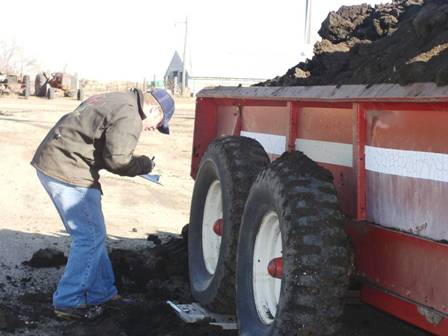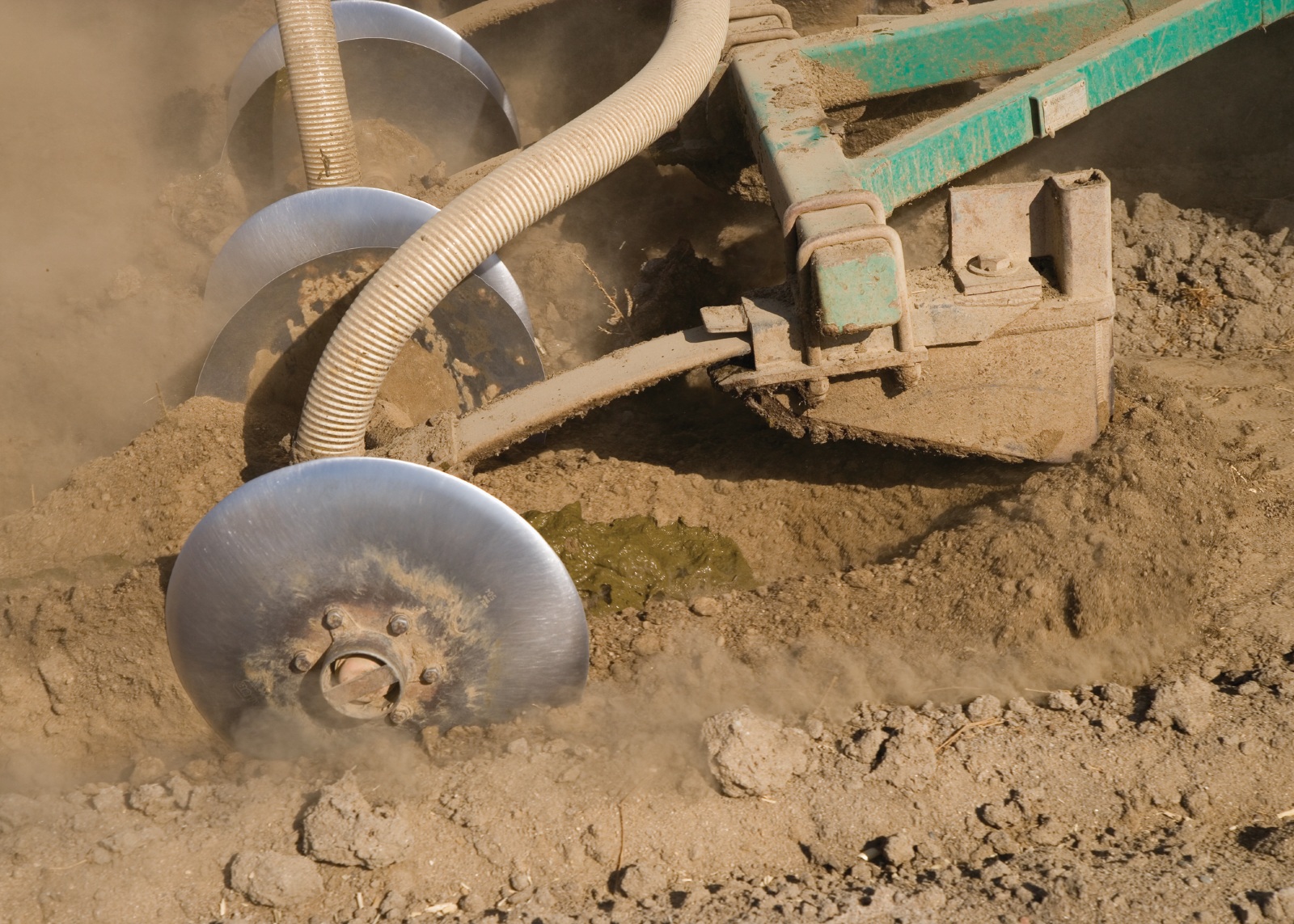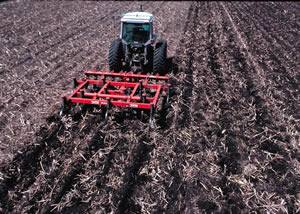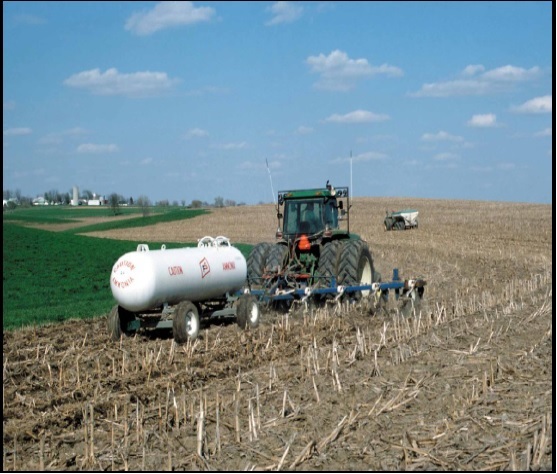-
Download:
My Results |
All BMPs
Manure Spreader Calibration
 Annual Record Keeping Requirements for Manure Management. Photo courtesy of Natural Resources Conservation Service South Dakota
Annual Record Keeping Requirements for Manure Management. Photo courtesy of Natural Resources Conservation Service South Dakota
Practice Type: Management
Landuse/Agriculture Type: Row Crop, Fodder, Pasture, Small Grains
Climatic Zones: Temperate, Semiarid, Tropical
Regions: North America, South Asia, Europe
Pollutants Treated: Nitrogen, Phosphorus, Sediment
Description: Manure spreader calibration involves determining the agronomic rate of manure and adjusting the spreader to apply manure at this ideal application rate on agricultural fields. Calibrating the spreader to agronomic rates ensures the nutrient needs of the crop are met and negative environmental impacts are minimized.1
Implementation Considerations: To calibrate a spreader, reliable estimates of the land area to which the manure will be applied and the amount to apply are necessary. The spreader must be recalibrated every time there is a change in manure nutrient concentrations, new equipment, or when a different application rate is desired. To maximize this practice, manure testing would be needed to accurately assess nutrient concentrations in the manure.
Scalable to small farms? Yes
Scaling Considerations: Should be able to be done under directions of trained agronomic extension personnel
1 Jokela, Bill. "Manure Spreader Calibration." SERA-17, Minimizing Phosphorus Losses from Agriculture. Web. Jan. 2014. http://www.sera17.ext.vt.edu/Documents/BMP_manure_spreader_calibration.pdf .
Manure/Fertilizer Incorporation
Category: Manure Management
Practice Type: Management
Landuse/Agriculture Type: Row Crop, Rice, Fodder, Pasture
Climatic Zones: Temperate, Semiarid, Tropical
Regions: North America, South Asia, Europe
Pollutants Treated: Nitrogen, Phosphorus, Sediment
Description: In many cropping systems, farmers have the opportunity to enhance fertilizer and manure efficiency and prevent nutrient losses by placing nutrients beneath the surface. In particular, incorporation of manure and fertilizers can decrease volatilization of nitrogen and increase plant availability. Incorporation can be accomplished with a broadcast application on the soil surface followed by tillage (using a disk or chisel) to incorporate the material. As more and more farmers adopt reduced tillage and no-till techniques, however, many choose to “band” their manure or fertilizer — placing nutrients in a narrow, concentrated, subsurface band near the seeds or seedlings. Typically, the manure and fertilizer is placed just below the seed furrow or a couple of inches to the side.
Implementation Considerations: Incorporation of manure/fertilzer requires more time than surface application and will require different machinery.
Scalable to small farms? Yes
Practice Type: Management
Landuse/Agriculture Type: Row Crop, Rice, Fodder, Pasture
Climatic Zones: Temperate, Semiarid, Tropical
Regions: North America, South Asia, Europe
Pollutants Treated: Nitrogen, Phosphorus, Sediment
Description: In many cropping systems, farmers have the opportunity to enhance fertilizer and manure efficiency and prevent nutrient losses by placing nutrients beneath the surface. In particular, incorporation of manure and fertilizers can decrease volatilization of nitrogen and increase plant availability. Incorporation can be accomplished with a broadcast application on the soil surface followed by tillage (using a disk or chisel) to incorporate the material. As more and more farmers adopt reduced tillage and no-till techniques, however, many choose to “band” their manure or fertilizer — placing nutrients in a narrow, concentrated, subsurface band near the seeds or seedlings. Typically, the manure and fertilizer is placed just below the seed furrow or a couple of inches to the side.
Implementation Considerations: Incorporation of manure/fertilzer requires more time than surface application and will require different machinery.
Scalable to small farms? Yes
Milkhouse Filters
 A modern milkhouse with milking machines that can be cleaned in place and drains that send wastewater to a treatment system. Photo courtesy of Karl Hakanson.
A modern milkhouse with milking machines that can be cleaned in place and drains that send wastewater to a treatment system. Photo courtesy of Karl Hakanson.
Practice Type: Structural, Management
Landuse/Agriculture Type: Animal Confinement
Climatic Zones: Temperate, Semiarid, Tropical
Regions: North America, Europe
Pollutants Treated: Phosphorus
Description: Milkhouse filters are vegetated and non-vegetated infiltration strips and septic type systems that are designed to treat milk house waste. This waste contains high concentrations of phosphorus (P) and total suspended solids due to the common use of phosphate-containing detergents and acid rinses, as well as the contributions of manure, feedstuffs and residual milk in waste. Filters help remove particulate P by settling the solids from waste and decrease dissolved P by promoting contact of wastewater with P sorbing materials. 1
Implementation Considerations: Milkhouse filters are best suited for better-drained sites, where local hydrology and wastewater dosing will not cause saturation of the soil in the filter strip. The slope of the land should be less than 15 percent to induce infiltration and reduce runoff. Because of risks to groundwater contamination, filters should not be sited on highly permeable soils or near wells.
Scalable to small farms? Yes
Scaling Considerations: For vegetated approaches
1 Kleinman, Peter, Larry Geohring, and Tammo Steenhuis. "Milkhouse Filters." SERA-17, Minimizing Phosphorus Losses from Agriculture. Web. June 2014.
Mulch Tillage (Conservation Tillage)
Category: Erosion Control
Practice Type: Management
Landuse/Agriculture Type: Row Crop, Small Grains, Fodder
Climatic Zones: Temperate, Semiarid, Tropical
Regions: North America, Europe
Pollutants Treated: Nitrogen, Phosphorus, Sediment
Description: Mulch tillage is a form of conservation tillage where more than 30% residue cover remains on the field after harvest, but the soil is tilled prior to planting by using tools such as chisels, field cultivators, discs, sweeps or blades. A portion of the crop residue is incorporated into the top few inches of soil. Mulch-tillage is useful on many different soils, including poorly drained soils, and increases roughness and infiltration more than conventional tillage. Because it is most similar to conventional tillage, mulch-tillage is the most likely of the systems to be tried first by a farmer. It is adaptable to a wide variety of soils. Mulch tillage also allows for the incorporation of surface-applied fertilizers and pesticides and provides more options for controlling weeds than most other conservation tillage types. This practice increases soil matter content and reduces ammonia volatilization. 1
Implementation Considerations: Mulch-tillage requires more trips across a field than other conservation tillage types. It is similar to conventional tillage in labor, equipment, and fuel costs. A farmer who uses mulch-tillage must maintain primary and secondary tillage implements or a combination implement. Some residue is buried which limits the erosion-reducing potential of the system.
Scalable to small farms? Yes
Scaling Considerations: Requires investments in new tillage implements
1 "Best Management Practices, Today's Agriculture: A Responsible Legacy." Nutrient Best Management Practices. Web. Aug. 2013. http://dda.delaware.gov/nutrients/D17762BestMgmtbklt.pdf .
Practice Type: Management
Landuse/Agriculture Type: Row Crop, Small Grains, Fodder
Climatic Zones: Temperate, Semiarid, Tropical
Regions: North America, Europe
Pollutants Treated: Nitrogen, Phosphorus, Sediment
Description: Mulch tillage is a form of conservation tillage where more than 30% residue cover remains on the field after harvest, but the soil is tilled prior to planting by using tools such as chisels, field cultivators, discs, sweeps or blades. A portion of the crop residue is incorporated into the top few inches of soil. Mulch-tillage is useful on many different soils, including poorly drained soils, and increases roughness and infiltration more than conventional tillage. Because it is most similar to conventional tillage, mulch-tillage is the most likely of the systems to be tried first by a farmer. It is adaptable to a wide variety of soils. Mulch tillage also allows for the incorporation of surface-applied fertilizers and pesticides and provides more options for controlling weeds than most other conservation tillage types. This practice increases soil matter content and reduces ammonia volatilization. 1
Implementation Considerations: Mulch-tillage requires more trips across a field than other conservation tillage types. It is similar to conventional tillage in labor, equipment, and fuel costs. A farmer who uses mulch-tillage must maintain primary and secondary tillage implements or a combination implement. Some residue is buried which limits the erosion-reducing potential of the system.
Scalable to small farms? Yes
Scaling Considerations: Requires investments in new tillage implements
1 "Best Management Practices, Today's Agriculture: A Responsible Legacy." Nutrient Best Management Practices. Web. Aug. 2013. http://dda.delaware.gov/nutrients/D17762BestMgmtbklt.pdf .
Nitrification Inhibitors
Category: Nutrient Management
Practice Type: Management
Landuse/Agriculture Type: Row Crop, Small Grains
Climatic Zones: Temperate, Semiarid, Tropical
Regions: North America
Pollutants Treated: Nitrogen
Description: Nitrification inhibitors slow the conversion of ammonium to nitrate and reduce N losses through leaching and denitrification. Conversion can be delayed between 4 to 6 weeks depending on soil temperature and pH. Nitrification inhibitors can be added to solid fertilizers before application. 1
Implementation Considerations: Nitrification inhibitors are most effective when applied at planting in poorly drained soils (where denitrification losses might occur) or in sandy soils (where leaching potential is high).
Scalable to small farms? Yes
Scaling Considerations: Cost and availability may be limiting factors for application on small and disadvantaged farms.
1 "Enhanced-Efficiency Nitrogen Sources." Agronomy Fact Sheet Series; Fact Sheet 45. Cornell University Cooperative Extension, 2009. http://nmsp.cals.cornell.edu/publications/factsheets/factsheet45.pdf
Practice Type: Management
Landuse/Agriculture Type: Row Crop, Small Grains
Climatic Zones: Temperate, Semiarid, Tropical
Regions: North America
Pollutants Treated: Nitrogen
Description: Nitrification inhibitors slow the conversion of ammonium to nitrate and reduce N losses through leaching and denitrification. Conversion can be delayed between 4 to 6 weeks depending on soil temperature and pH. Nitrification inhibitors can be added to solid fertilizers before application. 1
Implementation Considerations: Nitrification inhibitors are most effective when applied at planting in poorly drained soils (where denitrification losses might occur) or in sandy soils (where leaching potential is high).
Scalable to small farms? Yes
Scaling Considerations: Cost and availability may be limiting factors for application on small and disadvantaged farms.
1 "Enhanced-Efficiency Nitrogen Sources." Agronomy Fact Sheet Series; Fact Sheet 45. Cornell University Cooperative Extension, 2009. http://nmsp.cals.cornell.edu/publications/factsheets/factsheet45.pdf


